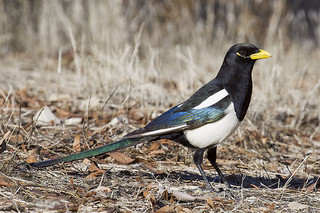
|
|
Yellow-billed Magpie - Pica nuttalliOverviewThe Yellow-billed Magpie is one of only two endemic Californian birds i.e. found exclusively in California. In its limited habitat, this magpie intrigues birdwatchers and tourists alike. Their loud calls, fights, and bright colors make watching them an exciting experience. Traveling in flocks, magpies live in a state of competition creating an entertaining spectacle. They eat a large range of foods including grubs, worms and fruit. Magpies build large nests made of sticks and mud in which they lay 6-8 eggs in February. They usually nest in oak or sycamore trees. For more information about all the birds of the Bay area see the Birds page. Where to ViewMagpies reside primarily in the Central Valley and the East Bay of California. They mostly live in open areas filled with oak trees. They do not move very far, so they are easy to find. Some tips for magpie watching:
For current sightings see the eBird Sightings Map. Here are some Bay area and nearby locations where you have a good chance of seeing the Yellow-billed Magpie:
Conservation StatusThe Yellow-billed Magpie is on the watch list, meaning it requires more attention and care. Magpies are killed via the poisoning of ground squirrels (by humans), and the destruction of their habitat. The IUCN Redlist classifies its status as of "Least Concern". This means that it has been evaluated to have a low risk of extinction. Articles/Links about Yellow-billed Magpies
Video |
